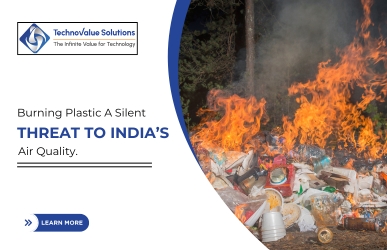Burning Plastic: A Silent Threat to India’s Air Quality
When we talk about air pollution, most of us imagine traffic, factories, or stubble burning. But there’s another silent culprit that doesn’t always make the headlines—burning plastic.
In India, plastic is everywhere. From packaging and bottles to disposable cutlery and wrappers, it’s deeply woven into our daily lives. But what happens when this plastic waste is burnt—intentionally in open fields, or unintentionally in landfills? The answer is worrying: it poisons the very air we breathe.
How Burning Plastic Affects Air Quality
When plastic burns, it doesn’t just disappear. Instead, it breaks down into toxic gases and tiny particles that enter the air:
- Toxic Fumes: Burning plastic releases harmful chemicals like dioxins, furans, and heavy metals. These are dangerous even in very small amounts.
- Particulate Matter (PM2.5 & PM10): Tiny particles mix with the air, making it harder to breathe and worsening smog.
- Greenhouse Gases: Plastics are made from fossil fuels, so burning them adds more carbon dioxide and methane to the atmosphere, fueling climate change.
India generates over 3.4 million tonnes of plastic waste every year. Not all of it gets recycled. A large share is dumped in open spaces or landfills, where burning is often used as the “easiest” way to reduce volume.
During winters, when Delhi and other northern states already struggle with poor air quality, plastic burning adds another invisible layer of danger. Unfortunately, many of these fires happen in small patches—making them harder to track but collectively devastating.
Adverse Effects on Health and Environment
- Human Health: Long-term exposure to plastic-burning smoke can lead to asthma, lung diseases, cardiovascular problems, and even certain cancers. Children and elderly people are at greater risk.
- Soil and Water Pollution: Toxic ash from burnt plastics can seep into soil and groundwater.
- Climate Impact: Greenhouse gases from burning plastics add to global warming, intensifying heatwaves and extreme weather.
What Can We Do Beyond Saying "No" to Plastic Bags?
Carrying a cloth bag is a good start, but the problem needs deeper solutions. Here’s how we can move forward:
Segregate Waste at Source
- If households and businesses separate plastics from organic waste, recycling becomes easier and reduces the chance of burning.
Promote Recycling & Upcycling
- Support businesses that turn plastic into useful products—like building materials, furniture, or clothing fibers.
Strict Monitoring & Enforcement
- Authorities must ensure waste isn’t openly burnt. Community-level monitoring and stricter penalties can help.
Better Waste Management Infrastructure
- Investments in waste-to-energy plants, plastic recycling facilities, and decentralized collection systems are crucial.
Citizen Awareness
- As individuals, we can spread awareness, report open burning in our neighborhoods, and make conscious choices about single-use plastic.
Innovation in Alternatives
- Encouraging biodegradable packaging, edible cutlery, and reusable solutions can reduce plastic dependency.
A Collective Responsibility
Plastic burning is not just an environmental problem—it’s a public health emergency. Every time we ignore a small pile of burning plastic in our street corner, we allow toxic chemicals to mix into the air that all of us breathe.
Solving this requires collective action—from policymakers and industries to communities and individuals. The path forward isn’t about eliminating all plastics overnight but about responsible production, better waste handling, and smarter alternatives.
The air we breathe is a shared resource. Let’s protect it together.
If you spot open plastic burning, don’t ignore it—raise your voice. Small actions, when multiplied, can bring cleaner skies for all.

